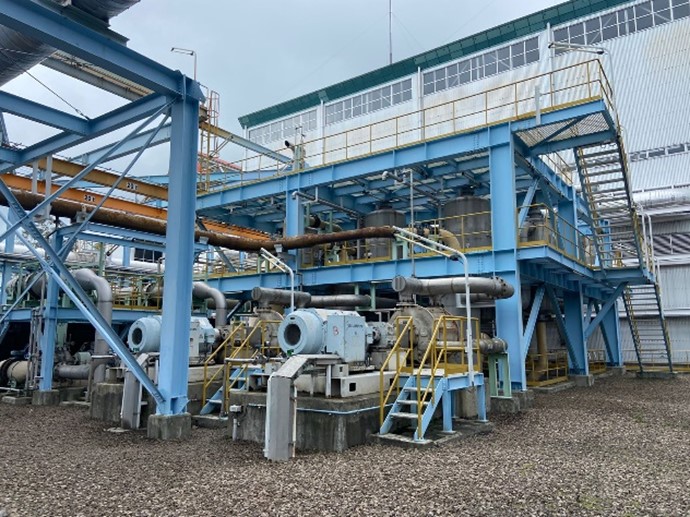Possibilities Study of a Non-condensable Gas Exhaust System through the Condensate Injection Pipe at PLTP Wayang Windu
DOI:
https://doi.org/10.25299/jgeet.2023.8.02-2.13878Keywords:
Non-Condensable Gas, Condensate, Gas Removal System, Geothermal, Carbon Capture, Reservoir, Condensate Reinjection, Pipeline, Flash Absorber, Power Plant, Eco-friendlyAbstract
Wayang Windu Geothermal Power Plant, located in Pangalengan, Bandung regency, West Java with an installed capacity of 227 MWe has two units to generate electricity and deliver to the Jawa, Madura, and Bali grid. The steam extracted from the reservoir contains non-condensable gas of about 1-1.2% of total steam extracted, with the gas composition is CO2 92%, H2S 2%, NH3 0.1%, and residual gasses 4.9%. Possibilities study of a non-condensable gas exhaust through the condensate injection pipe was created as the efforts in the environmental conservation aspect for reducing carbon released to the atmosphere and reinjected back into the reservoir. This study was simulated in Wayang Windu Unit 2 by calculating the non-condensable gas flow rate from the gas removal system into the condensate injection pipe near of cooling tower blowdown power station area. The analysis result of this study indicates that the non-condensable gas requires a higher flow rate of condensate to dissolve the entire non-condensable gas, and may cause the slug flow pattern which would endanger the condensate pipeline system also destabilize the non-condensable gas exhaust operation process from the condenser through the gas removal system. To deal with this problem, the possibility of exhausting the non-condensable gas produced by the gas removal system can be alternated by flowing its non-condensable gas into a flash absorber system and converting its non-condensable gas into other eco-friendly products and power plant safe.
Downloads
References
Aksoy, N, Gok, O. S, Mutlu.H and Kilinc, G. 2015. CO2 Emission from Geothermal Power Plant in Turkey. Proceedings World Geothermal Congress 2015. Melbourne, Australia, 19-25 April 2015.
Andritsos, N., Harnratty, T. J. 1987. Interfacial Instabilities for Horizontal Gas Liquid Flows in Pipelines. J. Multiphase Flow, 13, 583.
Beggs, H.D., and Brill, J.P., 1973. A Study of Two-Phase Flow in Inclined Pipes. JPT, Trans., AIME, 255.
Mamrosh, D. L, MCintush, Douglas, Fisher. Removal of Hydrogen Sulfide and Recovery of Carbon Dioxide from Geothermal Non-Condensable Gas Using Water.
Murray, 2001. Gases and Gas Exchange. Univ. Washington.
Ozcan, N. Y, Gokcen, G. 2010. Performance Analysis of Single-Flash Geothermal Power Plants: Gas Removal Systems Point of View. Proceedings World Geothermal Congress 2010 Bali, Indonesia, 25-29 April 2010.
Purwakusuma, A., 2016. study of non condensable gas exhaust system through condensate reinjection pipeline in Wayang Windu geothermal powerplant, Master's Program Thesis, Institut Teknologi Bandung.
Rybach, L. 2010. CO2 Emission Mitigation by Geothermal Development – Especially with Geothermal Heat Pumps. Proceedings World Geothermal Congress 2010 Bali, Indonesia, 25-29 April 2010.
Rogero, E. C., 2009. Experimental Investigation of Developing Plug and Slug Flows. Desertasi Doktor Ingineer. Technische Universität München: München,Germany.
Saptadji, N.M., 2002. Teknik Panas Bumi. Bandung: Departemen Teknik Perminyakan ITB.

Downloads
Published
Issue
Section
License
Copyright @2019. This is an open-access article distributed under the terms of the Creative Commons Attribution-ShareAlike 4.0 International License which permits unrestricted use, distribution, and reproduction in any medium. Copyrights of all materials published in JGEET are freely available without charge to users or / institution. Users are allowed to read, download, copy, distribute, search, or link to full-text articles in this journal without asking by giving appropriate credit, provide a link to the license, and indicate if changes were made. All of the remix, transform, or build upon the material must distribute the contributions under the same license as the original.










